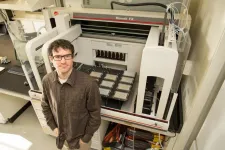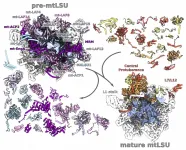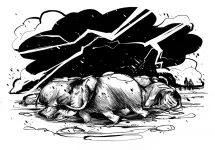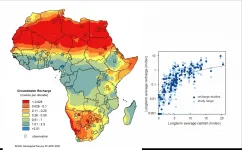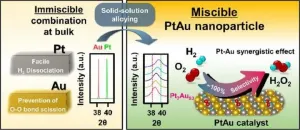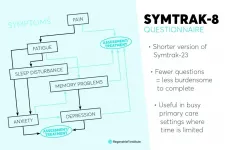(Press-News.org) If B is better than A, and C is better than B, it follows by the transitive property that C is better than A. And, yet, this is not always the case. Every kid is familiar with the Rock-Paper-Scissors game--the epitome of nontransitivity in which there is no clear hierarchy among the three choices, despite each two-way interaction having a clear winner: Paper beats Rock, Scissors beats Paper, and Rock beats Scissors.
Evolution may be teeming with nontransitive interactions as well. While natural selection - the process by which organisms better adapted to their environments are more likely to survive and pass on their genes - can be observed over shorter time intervals, there is still debate about whether fitness gains accumulate over long evolutionary time scales. In other words, one might expect that successive adaptive events (like the two-way interactions of Rock-Paper-Scissors) would translate into a cumulative increase in fitness, resulting in the very latest generation always being more fit than its all of its genealogical ancestors. However, this turns out to not be true in every case.
The evolutionary process, then, includes what are known as nontransitive interactions, sometimes producing organisms that are less fit than its ancestors. Experimental demonstrations of such nontransitivity, however, have been lacking.
Until now. A group of scientists at Lehigh University led by Gregory Lang, associate professor in the Department of Biological Sciences, has recently provided empirical evidence that evolution can be nontransitive. Lang and his team identify a nontransitive evolutionary sequence through a 1,000-generation yeast evolution experiment. In the experiment, an evolved clone outcompetes a recent ancestor but loses in direct competition with a distant ancestor.
The nontransitivity in this case arose as a result of multilevel selection that involved adaptive changes in both the yeast nuclear genome and the genome of an intracellular RNA virus. The results, which provide experimental evidence that the continuous action of selection can give rise to organisms that are less fit compared to a distant ancestor, are described in an article published in eLife Journal today called "Adaptive evolution of nontransitive fitness in yeast" (DOI: 10.7554/eLife.62238).
This study confronts two common misconceptions about evolution, according to Lang. The first, he says, is that evolution is a linear "march of progress" where each organism along a line of descent is more fit than all those that came before it.
Lang and his colleagues set out to determine how nontransitivity arose along a particular line of genealogical descent. In their 1,000-generation yeast experiment, nontransitivity arose due to adaptation in the yeast nuclear genome combined with the stepwise deterioration of an intracellular virus. Initially the population produced a virally encoded toxin and was immune to the toxin. As the population adapted, it fixed the beneficial nuclear mutations as well as mutations within the intracellular viral population that resulted in loss of toxin production. Over time the more beneficial nuclear mutations fix, and selection in the viral population resulted in a loss of toxin immunity - since the toxin was no longer produced. When placed in competition against its distant ancestor, the 1,000-generation evolved population lost due to the toxin produced by the ancestor.
"Another misconception is that there is a single locus of selection," says Lang. "Multilevel selection--as its name implies--states that selection can act simultaneously on multiple levels of biological organization."
In the context of this experiment, multilevel selection was common, says Lang. "Selection acts across multiple levels of biological organization, from genes within a cell to individuals within a population. Selection at one level can impact fitness at another.
"In fact, when we expanded our study of host-virus genome evolution to additional populations, we found that nearly half of the approximately 140 populations we studied experienced multilevel selection, fixing adaptive mutations in both the nuclear and viral genomes," he adds.
"Laboratory evolution experiments have proven highly effective for studying evolutionary principles, yet this work is the first to document a non-transitive interaction and provide a mechanistic explanation," says co-author Sean W. Buskirk, an assistant professor at West Chester University who collaborated on the research when a postdoctoral student in Lang's lab. "Ultimately, the presence of a virus in the ancestor drastically impacts how the evolved yeast populations compete and interact with one another."
The work of co-author Alecia B. Rokes, at the time an undergraduate biology major at Lehigh, focused on competing two intracellular viruses inside yeast cells in what she terms her very own "virus fight club."
"I worked on competing two viruses within the yeast cells to see if either virus variant had an advantage over the other, thus leading to higher frequency and one virus outcompeting the other," says Rokes, now a graduate student in microbiology at the University of Pittsburgh. "It was amazing to be part of the process of elimination, persistence, and pure curiosity that went into figuring out what was actually going on in these populations."
By showing that nontransitive interactions can arise along a line of genealogical succession, the team's work has broad implications for the scientific community's understanding of evolutionary processes.
"It resolves what evolutionary biologist Stephen Jay Gould referred to as 'the paradox of the first tier,' which is the failure to identify broad patterns of progress over long evolutionary time scales, despite clear evidence of selection acting over successive short time intervals," says Lang. "In addition, it calls into doubt whether true fitness maxima exist and, more broadly, it implies that directionality and progress in evolution may be illusory."
INFORMATION:
A new USC study puts ocean microbes in a new light with important implications for global warming.
The study, published Tuesday in the Proceedings of the National Academy of Sciences, provides a universal accounting method to measure how carbon-based matter accumulates and cycles in the ocean. While competing theories have often been debated, the new computational framework reconciles the differences and explains how oceans regulate organic carbon across time.
Surprisingly, most of the action involving carbon occurs not in the sky but underfoot and undersea. The Earth's plants, ...
The mitochondrial ribosome is an intricate machine that translates the organellar genome into functional proteins. The formation of the mitochondrial ribosome is a hierarchical process involving dozens of different components. The newly published cryo-EM study by Tobiasson et al in the EMBO Journal characterized a key step in this process.
A complex of 2.2 MegaDalton representing a rare state of assembly of the large subunit was isolated from a model organism Trypanosoma brucei. Since the state was identified in only 3.5 % of the complexes, five cryo-EM datasets had to be collected at the SciLifeLab facility and ESRF in Grenoble and combined together.
The resulting structure revealed ...
A new study published in Nature Communications suggests that the extinction of North America's largest mammals was not driven by overhunting by rapidly expanding human populations following their entrance into the Americas. Instead, the findings, based on a new statistical modelling approach, suggest that populations of large mammals fluctuated in response to climate change, with drastic decreases of temperatures around 13,000 years ago initiating the decline and extinction of these massive creatures. Still, humans may have been involved in more complex and indirect ways than simple models of overhunting suggest.
Before around 10,000 years ago, North America was ...
Effective governance and investment decisions need to be informed by reliable data, not only about where groundwater exists, but also the rate at which groundwater is replenished. For the first time using ground measurements, a recent study has quantified groundwater recharge rates across the whole of Africa - averaged over a fifty-year period - which will help to identify the sustainability of water resources for African nations.
The study, led by the British Geological Survey and involving an international team from the UK, South Africa, France, Nigeria, and America, developed a dataset of 134 existing recharge studies ...
Gender equity and racial diversity in medicine can promote creative solutions to complex health problems and improve the delivery of high-quality care, argue authors in an analysis in CMAJ (Canadian Medical Association Journal).
"[T]here is no excuse for not working to change the climate and environment of the medical profession so that it is welcoming of diversity," writes lead author Dr. Andrea Tricco, Knowledge Translation Program, Unity Health, and the University of Toronto, with coauthors. "The medical profession should be professional, be collegial, show mutual respect, and facilitate the full potential and contribution of all genders, races, ethnicities, religions and nationalities for the benefit of patient ...
NASA, in collaboration with other leading space agencies, aims to send its first human missions to Mars in the early 2030s, while companies like SpaceX may do so even earlier. Astronauts on Mars will need oxygen, water, food, and other consumables. These will need to be sourced from Mars, because importing them from Earth would be impractical in the long term. In Frontiers in Microbiology, scientists show for the first time that Anabaena cyanobacteria can be grown with only local gases, water, and other nutrients and at low pressure. This makes it much easier to develop sustainable biological life support systems.
"Here we show that cyanobacteria can use gases available in the Martian atmosphere, at a low total pressure, as their source of carbon and nitrogen. Under these conditions, ...
Hydrogen peroxide is used as a disinfectant, after dilution in water, to treat wounds. It is widely used across the industry as an eco-friendly oxidizing agent for impurity removal from semiconductors, waste treatment, etc. Currently, it is mainly produced by the sequential hydrogenation and oxidation of anthraquinone (AQ). However, this process is not only energy intensive and requires large-scale facilities, but AQ is also toxic.
As an alternative to the AQ process, hydrogen peroxide direct synthesis from hydrogen (H2) and oxygen (O2) using a palladium (Pd) catalyst was proposed. However, the commercialization of the technology ...
INDIANAPOLIS -- Researchers from Regenstrief Institute and Indiana University School of Medicine have developed and validated a short questionnaire to help patients report symptoms and assist healthcare providers in assessing the severity of symptoms, and in monitoring and adjusting treatment accordingly.
The tool, called SymTrak-8, is a shorter version of the SymTrak-23. The questionnaire tracks symptoms such as pain, fatigue, sleep disturbance, memory problems, anxiety and depression in older adults, enabling clinicians to provide better care for the diseases causing the symptoms.
"These symptoms are commonly reported in primary care, but they can be a sign of a variety of different diseases, so tracking them is important," said Kurt ...
Teens may be more likely to use marijuana after legalization for adult recreational use
PISCATAWAY, NJ - Adolescents who live in California may be more likely to use marijuana since adult recreational marijuana use was legalized in 2016, according to a new report in the Journal of Studies on Alcohol and Drugs.
"The apparent increase in marijuana use among California adolescents after recreational marijuana legalization for adult use in 2016 is surprising given the steady downward trend in marijuana use during years before legalization," says lead researcher Mallie J. ...
A new first-of-its-kind study has questioned whether pub operators can effectively and consistently prevent COVID-19 transmission - after researchers observed risks arising in licensed premises last summer.
Led by the University of Stirling, the research was conducted in May to August last year in a wide range of licensed premises which re-opened after a nationwide lockdown, and were operating under detailed guidance from government intended to reduce transmission risks.
While observed venues had made physical and operational modifications on re-opening, ...
